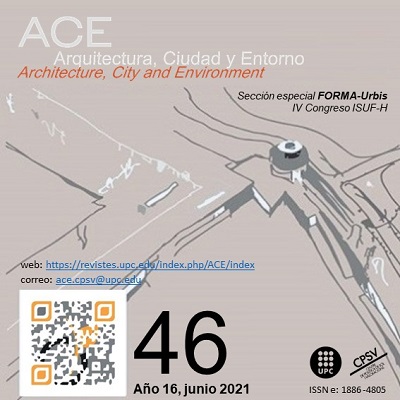To Build in a Place. Juan Antonio Molina Serrano: Towards Landscape, City and Dwelling
DOI:
https://doi.org/10.5821/ace.16.46.9756Keywords:
To build in a place, city, genius loci, Juan Antonio MolinaAbstract
The notions of resistance and renouncing constitute a pending issue in architecture, even today. Beyond the self-referential universe that certain interpretive angles of current architectural theory occupy, there are also other sensitive perspectives that cross the disciplinary limits and fracture the normally hegemonic discourses. There are new options in the field, proposing a new gaze that challenges reality as a social dimension and is aware of the importance of context, in all its dimensions, in the development of a project. The following lines synthesize some unprecedented reflections on the work of the Spanish architect Juan Antonio Molina. The purpose of this paper is to prove Molina’s assertiveness and attention towards landscape design, the city, and the social space created in those domains. In this line, three central axes are considered: interventions in the landscape, through the analysis of collective, domestic, and service or infrastructure scales; forays into the city, through the discussion of his encounters and affiliations with pre-existing spaces and the urban memory; and his proposals and initiatives related to the public space, which, ultimately, have become recovered spaces and places for social celebration (Pallasmaa, 2016). All of them, together, function as a resonance box for the inclusion of an ethical statement of principles. Combining a methodology focused on the exhaustive study of Molina’s projects (through memories, archives, interviews with the author, sources, etc.), together with experimentation and/or direct action (inhabiting buildings and case studies), my aim is to demonstrate the ways in which Molina’s work has evolved into and is related to, above all, a specific position: that of listening to the place, with the respect for the Genius Loci.
Downloads
Published
Issue
Section
License
| INTELECTUAL PROTECTION CRITERIA |
At this moment, it is count with the "Oficina Española de Patentes y Marcas", while global protection it is being processed by the World Intelectual Property Organization (OMPI/WIPO). Nevertheless the International Standard Serial Number Office (ISSN) has given the following numbers ISSN: 1886-4805 (electronic version) and 1887-7052 (paper version). All articles will be peer reviewed, using double blind reviewing. |
| COPYRIGHT |
The article contents and their comments are authors exclusive liability, and do not reflect necessarily the journal editor commitee's opinion. All ACE published works are subject to the following licence CC BY-NC-ND 3.0 ES http://creativecommons.org/licenses/by-nc-nd/3.0/es/ It implies that authors do not hold nor retain the copyright without restrictions but only those included in the licence. |





































